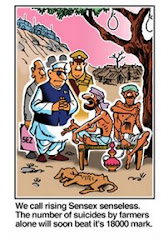
The US stock markets rose on Friday to cap there best week since November, as scattered bits of good news from shopping malls to metals markets gave some reason to believe that the economy may be getting closer to a bottom.
Consumers are still cutting back, but not as steeply as they were, data showed last week. Many retailers have reduced inventories on their shelves to the point that any pickup in demand will force them to restock. Prices for copper and scrap steel are rising, a hint that manufacturers are buying again. Oil prices are up 23% in the past four weeks, a sign demand may be firming. Shipping rates, sensitive to goods moving across the oceans, turned up even as governments reported declining world trade for January.
Most visibly, the stock market is up -- at least for now.
After falling to its lowest level in 12 years last Monday, the Dow Jones Industrial Average on Friday gained 53.92 points to close at 7223.98, clinching a 597.04-point, four-day rally. The Dow finished up 9.01% for the week, though it remains 49% below its October 2007 peak. The S&P 500 and Nasdaq composite indices also had their best weeks since the end of November.
Word this week from Citigroup Inc., J.P. Morgan Chase & Co. and Bank of America Corp. that their underlying businesses were profitable in the first months of the year -- along with the latest government reading on retail sales for February -- gave the market a "little assurance that, yes, there is a real economy out there and it has a chance of doing better," said Todd Clark, director of trading at Nollenberger Capital Markets.
Still, most economists say the U.S. economy will shrink at a very steep 5% annual rate or so in the current quarter, which ends March 31, and that it will continue to contract at a more modest pace in the second quarter.
Federal Reserve Chairman Ben Bernanke said this week that even if financial markets stabilize, he doesn't expect the recession to end until later this year. At several moments during the recession that began in December 2007, the worst appeared to be past -- and then the economy worsened.
While the US stock market is happier, debt markets aren't, though they're in better shape than they were late last year. The spread between U.S. Treasury yields and the yield on high-quality corporate bonds, measured by the Merrill Lynch High Grade Index, stands at a still-high 6 percentage points, though down from 6.50 as recently as mid December. A high spread is a sign that investors are demanding more money from borrowers to compensate them for heightened risk. The bond market is saying "economically you're in for a rough ride," said Greg Peters, head of fixed income research at Morgan Stanley.
President Barack Obama, speaking with reporters at the White House on Friday, said he was "confident" the country would get through the crisis, but warned that the U.S. won't enjoy a return to the euphoric times of earlier this decade. Days of overheated housing markets and maxed-out credit cards are over, he said. "We are laying a foundation for what I'm calling a 'post-bubble economic growth' that won't repeat the risks that led to the current crisis," he said.











